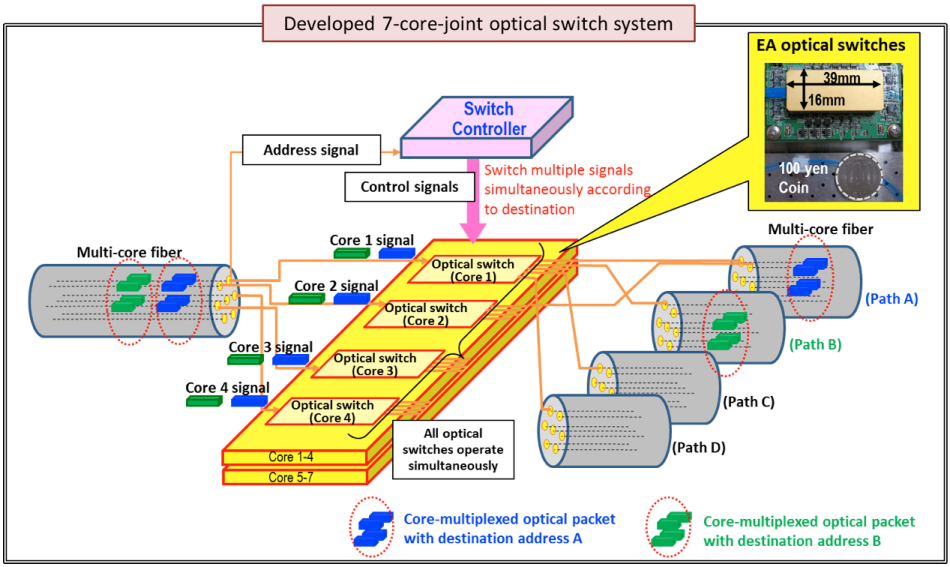Oct 9 2017
The National Institute of Information and Communications Technology (NICT, President: Hideyuki Tokuda, Ph.D.) has successfully demonstrated a world-record for switching capacity of 53.3 Tb/s for short-reach data-center networks.
 Concept diagram of high-speed 7-core-joint optical switch system (Credit: NICT)
Concept diagram of high-speed 7-core-joint optical switch system (Credit: NICT)
This demonstration makes use of spatial division multiplexing (SDM) over multi-core optical fibers (MCFs) and a newly developed high-speed spatial optical switch system, enabling full packet-granularity. We believe this newly developed data-center network provides a significant improvement of network efficiency and end-to-end energy consumption per bit compared to today's optical circuit, fully-electronic packet switching networks. The results of this demonstration were selected for presentation as a post-deadline paper at the prestigious 43rd European Conference on Optical Communications (ECOC) in Gothenburg, Sweden, on September 21, 2017.
Background
Due to a continuous increase of network traffic demand, the capacity of optical networks using standard single mode fiber (SMF) is approaching its physical limits. SDM technology, including MCFs, has been proposed to alleviate the capacity limits imposed by SMFs. Furthermore, it is also important to reduce the granularity of optical networks. Currently, commercial optical networks can switch optical wavelength channels that operate continuously in time. However, the actual information is transmitted over the network in smaller units, referred to as packets. Hence, the capability to transmit these packets directly on the optical domain can increase the overall network efficiency and replacing electronic switching with optical switching can also reduce the total end-to-end energy consumption per bit.
Achievements
In this work, NICT developed a high-speed 7-core-joint optical switching system that can switch all the cores of a 7-core MCF simultaneously with an ultrafast switching speed of 80 ns. The system consists of multiple electro-absorption (EA) optical switch elements with several nanoseconds switching speed. It also contains a switch controller, capable of reading the destination address of packets and controlling multiple EA switches simultaneously. The optical switching system can be used in an optical network switching node to realize several functions. Using this optical switching system, NICT built a testbed of a time-slotted optical network, capable of achieving full packet granularity. This testbed used 64 wavelength channels, modulated at 32 Giga Baud with polarization division multiplexing (PDM) quadrature phase shift keying (QPSK). This delivers a nominal capacity of 53.3 tera bits per second. In the testbed, three MCF segments were used: a 19-core 28 km fiber, a 19-core 10 km fiber, and a 7-core 2 km fiber. On each fiber, 7-cores were used in this demonstration to carry information signals. The results of this work were presented as a post-deadline paper on the prestigious 43rd European Conference on Optical Communications (ECOC), held in Gothenburg, Sweden, from September 17, 2017 until September 21, 2017.
Future Prospects
In the future, we hope to increase the network capacity by developing new optical switches with even faster response, lower insertion loss and flatter frequency response, and to investigate coherent burst-mode receivers with high-order modulation formats for greater spectral efficiency.